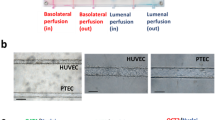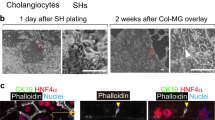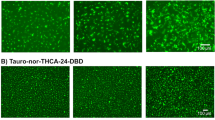Abstract
Morphine-6-glucuronide (M6G), the active metabolite of morphine, is currently in clinical development due to its higher analgesic activity. In humans, intravenously administered M6G was predominantly eliminated unchanged through the kidney, whereas it was excreted into the urine as parent drug as well as its metabolites morphine and M3G in normal rats. In bile-duct-cannulated rats, however, bile excretion of the parent drug was the main route of clearance. In the study, we investigated the mechanisms underlying the species differences in vivo disposition of M6G. In hepatocyte uptake assay, we showed that M6G uptake in rat hepatocytes was 75-fold higher than that in human hepatocytes. Hepatic uptake transporter phenotyping study identified M6G as a substrate for rat rOatplal, rOatpla4, rOatp1b2, as well as for human hOATP1B1 and hOATP1B3. Among these, rOatps exhibited significantly stronger uptake of M6G compared to hOATPs. Furthermore, M6G was not a substrate for the canalicular efflux transporters MDR1, hBCRP/rBcrp, hBSEP/rBsep, and hMRP2, but it was recognized by rMrp2. These findings aligned with the observation that M6G exhibited significant biliary excretion in the rat sandwich cultured hepatocyte (SCH) model, but not in the human SCH. Additionally, no species differences were observed in renal uptake mediated by OAT3. Overall, M6G underwent renal clearance in humans via glomerular filtration and active secretion primarily mediated by hOAT3. Although a portion of M6G was also eliminated through the kidney in rats, the majority was subjected to enterohepatic circulation mediated primarily by rOatps and rMrp2, leading to the formation of morphine and M3G, which were subsequently excreted in the urine. The marked difference in the uptake activities of sinusoidal transporters hOATPs/rOatps and the substrate specificity of canalicular transporters hMRP2/rMrp2 were critical factors underlying the species differences in the hepatobiliary disposition of M6G.
This is a preview of subscription content, access via your institution
Access options
Subscribe to this journal
Receive 12 print issues and online access
$259.00 per year
only $21.58 per issue
Buy this article
- Purchase on SpringerLink
- Instant access to full article PDF
Prices may be subject to local taxes which are calculated during checkout









Similar content being viewed by others
References
Hasselstrom J, Sawe J. Morphine pharmacokinetics and metabolism in humans. Enterohepatic cycling and relative contribution of metabolites to active opioid concentrations. Clin Pharmacokinet. 1993;24:344–54.
Coffman BL, Rios GR, King CD, Tephly TR. Human UGT2B7 catalyzes morphine glucuronidation. Drug Metab Dispos. 1997;25:1–4.
Moran TD, Smith PA. Morphine-3beta-D-glucuronide suppresses inhibitory synaptic transmission in rat substantia gelatinosa. J Pharmacol Exp Ther. 2002;302:568–76.
Lotsch J, Geisslinger G. Morphine-6-glucuronide: an analgesic of the future?. Clin Pharmacokinet. 2001;40:485–99.
Romberg R, Olofsen E, Sarton E, den Hartigh J, Taschner PE, Dahan A. Pharmacokinetic-pharmacodynamic modeling of morphine-6-glucuronide-induced analgesia in healthy volunteers: absence of sex differences. Anesthesiology. 2004;100:120–33.
Francés B, Gout R, Campistron G, Panconi E, Cros J. Morphine-6-glucuronide is more mu-selective and potent in analgesic tests than morphine. Prog Clin Biol Res. 1990;328:477.
Mikus G, Klimas R. Relative contribution of morphine and morphine-6-glucuronide to the analgesic effect after morphine administration. Br J Anaesth. 2015;114:1007.
Penson RT, Joel SP, Roberts M, Gloyne A, Beckwith S, Slevin ML. The bioavailability and pharmacokinetics of subcutaneous, nebulized and oral morphine-6-glucuronide. Br J Clin Pharmacol. 2002;53:347–54.
Osborne R, Thompson P, Joel S, Trew D, Patel N, Slevin M. The analgesic activity of morphine-6-glucuronide. Br J Clin Pharmacol. 1992;34:130–8.
Funk C. The role of hepatic transporters in drug elimination. Expert Opin Drug Metab Toxicol. 2008;4:363–79.
Giacomini KM, Huang SM, Tweedie DJ, Benet LZ, Brouwer KL, Chu XY, et al. Membrane transporters in drug development. Nat Rev Drug Discov. 2010;9:215–36.
Prasad B, Evers R, Gupta A, Hop CE, Salphati L, Shukla S, et al. Interindividual variability in hepatic organic anion-transporting polypeptides and P-glycoprotein (ABCB1) protein expression: quantification by liquid chromatography tandem mass spectroscopy and influence of genotype, age, and sex. Drug Metab Dispos. 2014;42:78–88.
Wang L, Prasad B, Salphati L, Chu XY, Gupta A, Hop CE, et al. Interspecies variability in expression of hepatobiliary transporters across human, dog, monkey, and rat as determined by quantitative proteomics. Drug Metab Dispos. 2015;43:367–74.
Prasad B, Lai YR, Lin Y, Unadkat JD. Interindividual variability in the hepatic expression of the human breast cancer resistance protein (BCRP/ABCG2): effect of age, sex, and genotype. J Pharmacol Sci. 2013;102:787–93.
Deo AK, Prasad B, Balogh L, Lai YR, Unadkat JD. Interindividual variability in hepatic expression of the multidrug resistance-associated protein 2 (MRP2/ABCC2): quantification by liquid chromatography/tandem mass spectrometry. Drug Metab Dispos. 2012;40:852–5.
van de Wetering K, Zelcer N, Kuil A, Feddema W, Hillebrand M, Vlaming MLH, et al. Multidrug resistance proteins 2 and 3 provide alternative routes for hepatic excretion of morphine-glucuronides. Mol Pharmacol. 2007;72:387–94.
Zelcer N, van de Wetering K, Hillebrand M, Sarton E, Kuil A, Wielinga PR, et al. Mice lacking multidrug resistance protein 3 show altered morphine pharmacokinetics and morphine-6-glucuronide antinociception. Proc Natl Acad Sci USA. 2005;102:7274–9.
Yang ZZ, Li L, Wang L, Xu MC, An S, Jiang C, et al. siRNA capsulated brain-targeted nanoparticles specifically knock down OATP2B1 in mice: a mechanism for acute morphine tolerance suppression. Sci Rep. 2016;6:33338.
Bourasset F, Cisternino S, Temsamani J, Scherrmann JM. Evidence for an active transport of morphine-6-beta-d-glucuronide but not P-glycoprotein-mediated at the blood-brain barrier. J Neurochem. 2003;86:1564–7.
Lötsch J, Schmidt R, Vetter G, Schmidt H, Niederberger E, Geisslinger G, et al. Increased CNS uptake and enhanced antinociception of morphine-6-glucuronide in rats after inhibition of P-glycoprotein. J Neurochem. 2002;83:241–8.
Huwyler J, Drewe J, Klusemann C, Fricker G. Evidence for P-glycoprotein-modulated penetration of morphine-6-glucuronide into brain capillary endothelium. Br J Pharmacol. 1996;118:1879–85.
Sattari M, Routledge P, Mashayekhi S. The influence of active transport systems on morphine -6-glucuronide transport in MDCKII and MDCK-PGP cells. Daru. 2011;19:412–6.
Berry MN, Friend DS. High-yield preparation of isolated rat liver parenchymal cells: a biochemical and fine structural study. J Cell Biol. 1969;43:506–20.
Han YH, Busler D, Hong Y, Tian Y, Chen C, Rodrigues AD. Transporter studies with the 3-O-sulfate conjugate of 17alpha-ethinylestradiol: assessment of human liver drug transporters. Drug Metab Dispos. 2010;38:1072–82.
Li XL, Zhong K, Guo ZT, Zhong DF, Chen XY. Fasiglifam (TAK-875) inhibits hepatobiliary transporters: a possible factor contributing to fasiglifam-induced liver injury. Drug Metab Dispos. 2015;43:1751–9.
Guo ZT, Liu ML, Meng J, Xue YR, Huang Q, Zheng YD, et al. Mechanistic study on the species differences in excretion pathway of HR011303 in humans and rats. Drug Metab Dispos. 2022;50:809–18.
Houston JB, Kenworthy KE. In vitro-in vivo scaling of CYP kinetic data not consistent with the classical Michaelis-Menten model. Drug Metab Dispos. 2000;28:246–54.
Liu X, LeCluyse EL, Brouwer KR, Gan LS, Lemasters JJ, Stieger B, et al. Biliary excretion in primary rat hepatocytes cultured in a collagen-sandwich configuration. Am J Physiol. 1999;277:G12–21.
Pan GY, Boiselle C, Wang J. Assessment of biliary clearance in early drug discovery using sandwich-cultured hepatocyte model. J Pharmacol Sci. 2012;101:1898–908.
Hammer H, Schmidt F, Marx-Stoelting P, Pötz O, Braeuning A. Cross-species analysis of hepatic cytochrome P450 and transport protein expression. Arch Toxicol. 2020;1:117–33.
Martignoni M, Groothuis GM, de Kanter R. Species differences between mouse, rat, dog, monkey and human CYP-mediated drug metabolism, inhibition and induction. Expert Opin Drug Metab Toxicol. 2006;2:875–94.
Dalgaard L. Comparison of minipig, dog, monkey and human drug metabolism and disposition. J Pharmacol Toxicol Methods. 2015;74:80–92.
Komura H, Iwaki M. In vitro and in vivo small intestinal metabolism of CYP3A and UGT substrates in preclinical animals species and humans: species differences. Drug Metab Rev. 2011;43:476–98.
Nishimuta H, Nakagawa T, Nomura N, Yabuki M. Species differences in hepatic and intestinal metabolic activities for 43 human cytochrome P450 substrates between humans and rats or dogs. Xenobiotica. 2013;43:948–55.
Hagenbuch B, Meier PJ. Organic anion transporting polypeptides of the OATP/ SLC21 family: phylogenetic classification as OATP/SLCO superfamily, new nomenclature and molecular/functional properties. Pflugers Arch. 2004;447:653–65.
Nakakariya M, Shimada T, Irokawa M, Maeda T, Tamai I. Identification and species similarity of OATP transporters responsible for hepatic uptake of β-lactam antibiotics. Drug Metab Pharmacokinet. 2008;23:347–55.
U.S. Food and Drug Administration, Center for Drug Evaluation and Research. In vitro drug interaction studies—cytochrome P450 enzyme- and transporter-mediated drug interactions: guidance for industry [Internet]. Silver Spring (MD): U.S. Food and Drug Administration; 2020.
Choi MK, Kim H, Han YH, Song IS, Shim CK. Involvement of Mrp2/MRP2 in the species different excretion route of benzylpenicillin between rat and human. Xenobiotica. 2009;39:171–81.
Järvinen E, Deng F, Kiander W, Sinokki A, Kidron H, Sjöstedt N. The role of uptake and efflux transporters in the disposition of glucuronide and sulfate conjugates. Front Pharmacol. 2021;12:802539.
Zamek-Gliszczynski MJ, Lee CA, Poirier A, Bentz J, Chu X, Ellens H, et al. ITC recommendations for transporter kinetic parameter estimation and translational modeling of transport-mediated PK and DDIs in humans. Clin Pharmacol Ther. 2013;94:64–79.
Klimas R, Mikus G. Morphine-6-glucuronide is responsible for the analgesic effect after morphine administration: a quantitative review of morphine, morphine-6-glucuronide, and morphine-3-glucuronide. Br J Anaesth. 2014;113:935–44.
Wu D, Kang YS, Bickel U, Pardridge WM. Blood-brain barrier permeability to morphine-6-glucuronide is markedly reduced compared with morphine. Drug Metab Dispos. 1997;25:768–71.
De Bruyn T, Ufuk A, Cantrill C, Kosa RE, Bi YA, Niosi M, et al. Predicting human clearance of organic anion transporting polypeptide substrates using cynomolgus monkey: in vitro-in vivo scaling of hepatic uptake clearance. Drug Metab Dispos. 2018;46:989–1000.
Grime K, Paine SW. Species differences in biliary clearance and possible relevance of hepatic uptake and efflux transporters involvement. Drug Metab Dispos. 2013;41:372–8.
Liao M, Zhu Q, Zhu A, Gemski C, Ma B, Guan E, et al. Comparison of uptake transporter functions in hepatocytes in different species to determine the optimal model for evaluating drug transporter activities in humans. Xenobiotica. 2019;49:852–62.
Acknowledgements
This research was partly supported by the National Natural Science Foundation of China (82373939) and State Key Laboratory of Drug Research, Shanghai Institute of Materia Medica, Chinese Academy of Sciences, Shanghai 201203, China.
Author information
Authors and Affiliations
Contributions
ZTG and XYC participated in research design and wrote or contributed to the writing of the manuscript; ZTG performed the data analysis; ZTG, HW, and NJX conducted the animal experiments. ZTG, YFZ, MLZ, XYK, and JW conducted the transporter and hepatocytes experiments, and QZ provided technical or material support.
Corresponding author
Ethics declarations
Competing interests
The authors declare no competing interests.
Additional information
Publisher’s note Springer Nature remains neutral with regard to jurisdictional claims in published maps and institutional affiliations.
Rights and permissions
Springer Nature or its licensor (e.g. a society or other partner) holds exclusive rights to this article under a publishing agreement with the author(s) or other rightsholder(s); author self-archiving of the accepted manuscript version of this article is solely governed by the terms of such publishing agreement and applicable law.
About this article
Cite this article
Guo, Zt., Wang, H., Xie, Nj. et al. Species differences in the hepatobiliary disposition of morphine-6-glucuronide mediated by hepatic transporters in rats and humans. Acta Pharmacol Sin (2025). https://doi.org/10.1038/s41401-025-01658-9
Received:
Accepted:
Published:
DOI: https://doi.org/10.1038/s41401-025-01658-9



